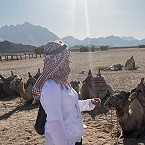In 1936 Hassan uncovered a stela of Amenhotep II near the Great Sphinx of Giza, which implies the two larger pyramids were still attributed to Khufu and Khafre in the New Kingdom. It reads: "He yoked the horses in Memphis, when he was still young, and stopped at the Sanctuary of Hor-em-akhet (the Sphinx). He spent a time there in going round it, looking at the beauty of the Sanctuary of Khufu and Khafra the revered."[20]
In 1954 two boat pits, one containing the Khufu ship, were discovered buried at the south foot of the pyramid. The cartouche of Djedefre was found on many of the blocks that covered the boat pits. As the successor and eldest son he would have presumably been responsible for the burial of Khufu.[21] The second boat pit was examined in 1987; excavation work started in 2010. Graffiti on the stones included 4 instances of the name "Khufu", 11 instances of "Djedefre", a year (in reign, season, month and day), measurements of the stone, various signs and marks, and a reference line used in construction, all done in red or black ink.[22]
During excavations in 2013 the Diary of Merer was found at Wadi al-Jarf. It documents the transportation of white limestone blocks from Tura to the Great Pyramid, which is mentioned by its original name Akhet Khufu (with a pyramid determinative) dozens of times. It details that the stones were accepted at She Akhet-Khufu ("the pool of the pyramid Horizon of Khufu") and Ro-She Khufu ("the entrance to the pool of Khufu"), which were under supervision of Ankhhaf, half brother and vizier of Khufu, as well as owner of the largest mastaba of the Giza East Field.[3]
Age
Quick Search

Prices & Services
Letters from 2$
Fast Gift Delivery
2-way Video Chat
5 Membership Levels
View all rates
